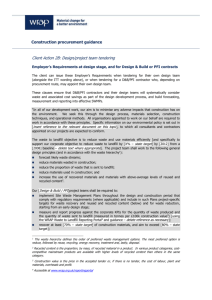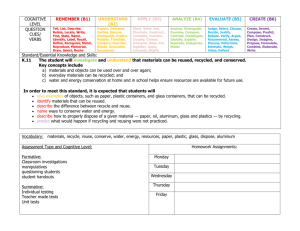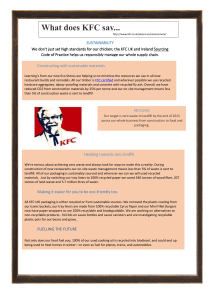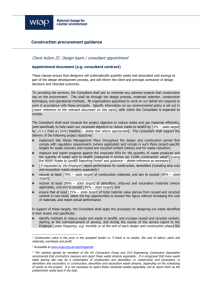Client Action 2A: Design team tendering
advertisement
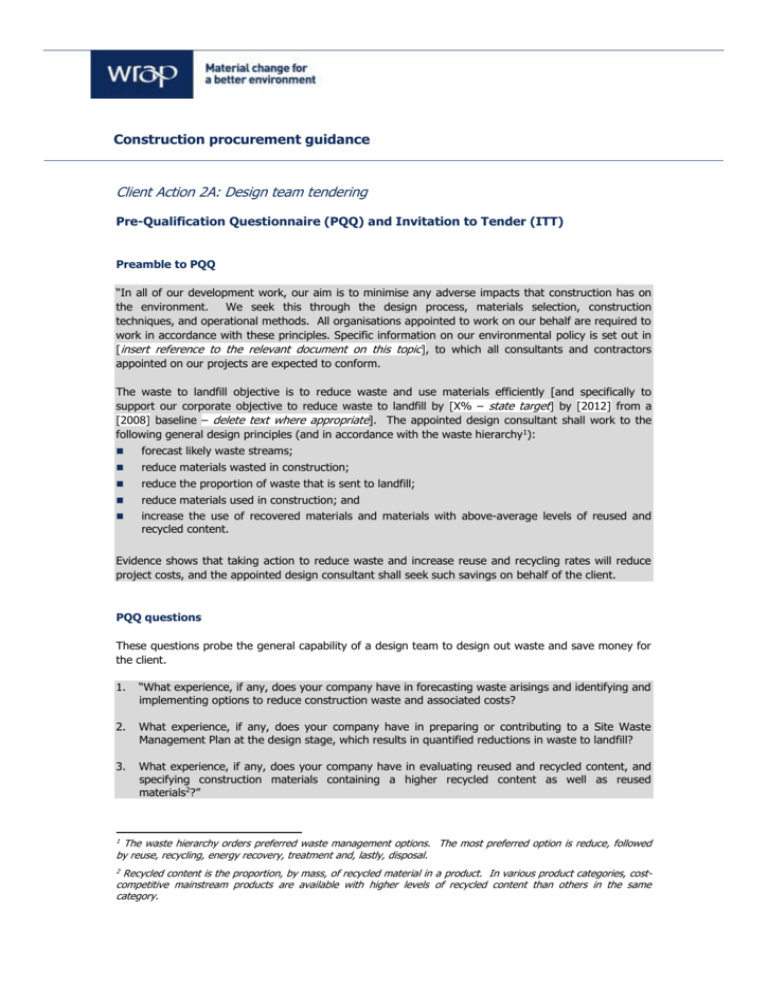
Construction procurement guidance Client Action 2A: Design team tendering Pre-Qualification Questionnaire (PQQ) and Invitation to Tender (ITT) Preamble to PQQ “In all of our development work, our aim is to minimise any adverse impacts that construction has on the environment. We seek this through the design process, materials selection, construction techniques, and operational methods. All organisations appointed to work on our behalf are required to work in accordance with these principles. Specific information on our environmental policy is set out in [insert reference to the relevant document on this topic], to which all consultants and contractors appointed on our projects are expected to conform. The waste to landfill objective is to reduce waste and use materials efficiently [and specifically to support our corporate objective to reduce waste to landfill by [X% – state target] by [2012] from a [2008] baseline – delete text where appropriate]. The appointed design consultant shall work to the following general design principles (and in accordance with the waste hierarchy1): forecast likely waste streams; reduce materials wasted in construction; reduce the proportion of waste that is sent to landfill; reduce materials used in construction; and increase the use of recovered materials and materials with above-average levels of reused and recycled content. Evidence shows that taking action to reduce waste and increase reuse and recycling rates will reduce project costs, and the appointed design consultant shall seek such savings on behalf of the client. PQQ questions These questions probe the general capability of a design team to design out waste and save money for the client. 1. “What experience, if any, does your company have in forecasting waste arisings and identifying and implementing options to reduce construction waste and associated costs? 2. What experience, if any, does your company have in preparing or contributing to a Site Waste Management Plan at the design stage, which results in quantified reductions in waste to landfill? 3. What experience, if any, does your company have in evaluating reused and recycled content, and specifying construction materials containing a higher recycled content as well as reused materials2?” The waste hierarchy orders preferred waste management options. The most preferred option is reduce, followed by reuse, recycling, energy recovery, treatment and, lastly, disposal. 1 Recycled content is the proportion, by mass, of recycled material in a product. In various product categories, costcompetitive mainstream products are available with higher levels of recycled content than others in the same category. 2 Construction procurement guidance An ideal PQQ response would provide the following details: project experience illustrating how the bidder has previously identified waste streams, forecasted waste arisings and investigated waste reduction and recovery options at an early design stage; project experience illustrating how the bidder contributed towards a Site Waste Management Plan that reduced waste to landfill; examples showing how the bidder affected the selection of construction materials containing higher levels of recycled content; examples of how the bidder has designed projects to reuse in situ, excavation and demolition materials in the past; examples showing how the bidder has previously collaborated with their supply chain to deliver these outcomes. Preamble to ITT “In all of our development work, our aim is to minimise any adverse impacts that construction has on the environment. We seek this through the design process, materials selection, construction techniques, and operational methods. All organisations appointed to work on our behalf are required to work in accordance with these principles. Specific information on our environmental policy is set out in [insert reference to the relevant document on this topic], to which all consultants and contractors appointed on our projects are expected to conform. The waste to landfill objective is to reduce waste and use materials efficiently [and specifically to support our corporate objective to reduce waste to landfill by [X% – state target] by [2012] from a [2008] baseline – delete text where appropriate]. The appointed design consultant shall work to the following general design principles (and in accordance with the waste hierarchy3): forecast likely waste streams; reduce materials wasted in construction; reduce the proportion of waste that is sent to landfill; reduce materials used in construction; and increase the use of recovered materials and materials with above-average levels of reused and recycled content4. Evidence shows that taking action to reduce waste and increase reuse and recycling rates will reduce project costs. For this reason, your services should identify how to achieve these outcomes most effectively5. Designers may wish to refer to the ‘basic principles of designing out waste’, contained in the WRAP Designing out Waste guidance6.” The waste hierarchy orders preferred waste management options. The most preferred option is reduce, followed by reuse, recycling, energy recovery, treatment and, lastly, disposal. 3 Recycled content is the proportion, by mass, of recycled material in a product. In various product categories, costcompetitive mainstream products are available with higher levels of recycled content than others in the same category. 4 WRAP’s Net Waste Tool can be used to forecast wastage and set targets for waste reduction and recovery from the design stage. The same tool will evaluate reused and recycled content. The tool is freely accessible at www.wrap.org.uk/nwtool. The Designing out Waste Tools for Buildings and for Civil Engineering are available at the same web address and provide a simple and rapid evaluation at an earlier stage of design. 5 Designing out Waste guidance www.wrap.org.uk/designingoutwaste. 6 for buildings and infrastructure are available at Construction procurement guidance ITT wording These clauses ask designers to explain how they will systematically consider waste and maximise cost savings as part of the design development process. “We require designers to respond to this tender specifically listing: a) how you will identify, prioritise and select options to design out waste, set targets for waste reduction, and increase reused and recycled content on this project; b) how you will maximise the use of demolition, in situ and excavation materials [delete as appropriate]; c) how you will embed information into a Site Waste Management Plan and communicate design decisions; and d) how you propose to contribute most effectively to meeting our cost saving and Waste to Landfill objectives. Responses should be SMART (Specific, Measurable, Achievable, Realistic & Time-based).” An ideal ITT response would provide the following details: an outline of their method to reduce construction waste and increase the use of reused and recycled content through design, that integrates Designing out Waste into the project from an early stage (e.g. following the principles set out in WRAP guidance on Designing out Waste 7); specific proposals showing a workable solution to setting and meeting project targets for waste reduction and reused and recycled content, including selection of the most cost-effective options – which would typically involve identifying around five design changes with the most significant impact and around five product materials categories where options with higher reused/recycled content are available on the market at a competitive cost; where strip out, demolition and excavation will take place, the bidder should show experience of reusing such materials, and specify how they will be used on this project; pre-demolition audits and ground / site investigations can help with this and the bidder should refer to using this information; where ground work is involved, the bidder should show experience in maximising the value of in situ materials avoiding the need for excavation if possible; ground / site investigations can help with this and the bidder should refer to using this information; explanation of how they will help develop the SWMP – forecasting waste, and capturing design actions that will reduce construction wastes; explanation of how their approach will help to cut your costs and contribute towards your longer term Waste to Landfill objective, including solutions to project-specific barriers and constraints; and responses which are SMART (Specific, Measurable, Achievable, Realistic & Time-based). Designing out Waste guidance www.wrap.org.uk/designingoutwaste. 7 for buildings and infrastructure are available at

